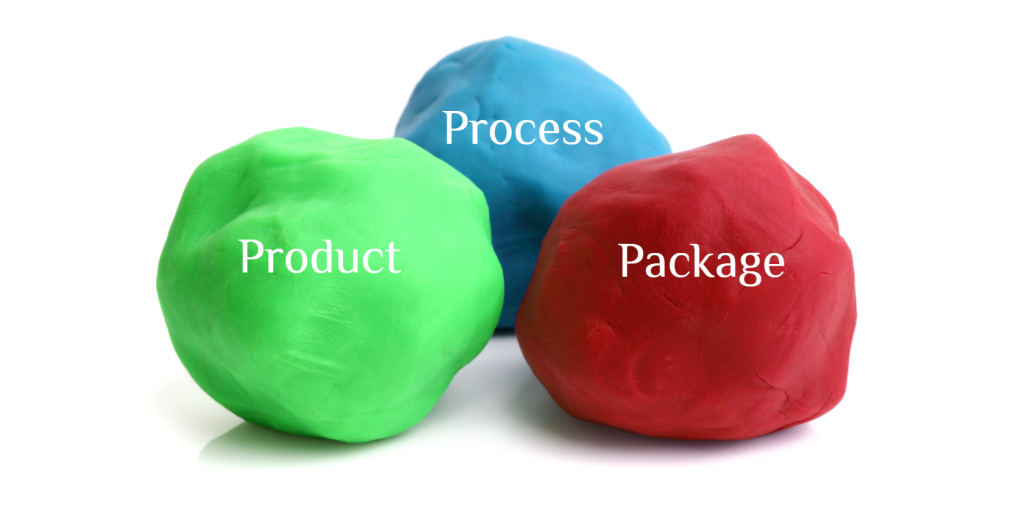Many of us have heard of the 5 P’s of Marketing – Product, Price, Promotion, Place, and People – key marketing elements used to strategically position a business. But have you heard about the 3P’s of Product Development?
Regardless of which consumer product segment you come from, you know that product development can take anywhere from a few weeks to a few years. In some cases, it makes sense that developing new-to-the-world and novel products which need validation, testing, studies, etc. will take a long time.
However, in my experience, most of the product development processes are too long because of surprises: surprises that are the result of not working on the 3P’s of Product Development together from the beginning: Product, Package, and Process.
Most of the time when we are designing a new product we stay focused on the formula, design, and characteristics of the product itself. We tweak and tweak until we get what we like. And then we’re done, right?? Not exactly. Once we finish creating the product and start thinking about processing and packaging, surprises start to pop up.
This reminds me of something I learned early on in my career. Even before I started on my food science degree, I loved food and playing around with recipes, including making jams and jellies. During the summer I would turn any fruit and even vegetables into jam. And for the most part, they were pretty good!
Then my first job out of school was as a product development scientist at a food processing factory making jams – it was like destiny! I thought it would be so easy because I knew a lot about making jams. Then the reality of commercial production hit me and the surprises kept coming.
- Surprise 1: Scaling up to tons when I was used to making a pound or two in the kitchen or in the lab was not just a matter of multiplication.
- Surprise 2: Processing equipment and the environment made a big difference. Making the exact same recipe using two different types of equipment made such a difference in color, texture, and taste!
- Surprise 3: Different packaging materials interacted differently with the same product, so we needed different recipes for each type of packaging.
Years later when I was in the beauty industry, the importance of developing formulas with the final package and processing capabilities in mind during formulation became even more evident. Weeks of stability studies had to be redone with any slight change to packaging material. The slightest change in processing and environment would cause a long-standing formula to separate, change color or undergo a variety of other changes.
Luckily, the lesson I learned early in my career that the “Three P’s of Product Development” must be worked on together from the beginning of the process has helped me avoid unpleasant surprises many times.
It seems so intuitive, so why don’t we follow this approach all the time?
The answer usually has to do with speed.
We want to accelerate product development so we can launch the product as quickly as possible. We make samples and start testing and validations, thinking that once the product is finalized we can then decide on packaging and processing. We assume that if our samples (mostly lab or bench samples) work, it can easily be replicated in production and with different types of packaging.
Although this approach may work some of the time, most of the time it won’t! This may sound random, but it is not random at all. It all goes back to why we decided not to work on the 3P’s together from the beginning.
If it was because we thought doing so would slow us down, then chances are the end result will not be what we hoped for. However, if we made that decision based on assessing the risk and determined that the risk was low, that is a different story.
But how do we assess risk? A simple rule of thumb is to ask three simple questions, and if the answer to any of those questions is “No” then the risk of not figuring “Packaging” and “Processing” before making product samples and starting testing and validations is high.
- Has your processing partner (owned or contracted) manufactured the same or similar formula/recipe before?
- Has this formula or a similar one been packaged in exactly the same materials you have in mind (by your processing partner or competitors)?
- Does the processing facility currently have the capability to run the types of packaging you may have in mind?
Of course, these three questions are only a start. Using a proven product development process – such as a stage/gate process – would help you keep track of all important elements and details that, if missed, could cost you time, money, or quality as well as your customer’s trust.
Always remember that your products should be innovative and novel but your product development process shouldn’t be. The process needs to be tested and proven to deliver results with minimal cost and maximum quality in the fastest possible time.
Even more importantly, throughout the process, you need to engage with the right expertise at the right time. From formulator to packaging engineer and processing expert, to product safety and regulatory, early engagement is key to flawless product launches.
Whether these experts are in-house or you reach out to them as partners and advisors, this early engagement and investment in the right expertise will pay dividends and deliver the highest rate of return on your investment.
If you don’t know where to find the expertise you need, visit our website www.JitExpertsHive.com or email us at info@jitexpertshive.com.

